India is too big, too diverse, and too exotic to see in one trip. In fact, an entire lifetime may not be enough to see it. However, we have hand-picked a collection a few grand monuments that are a must visit to get an insightful glimpse of this mysterious land.
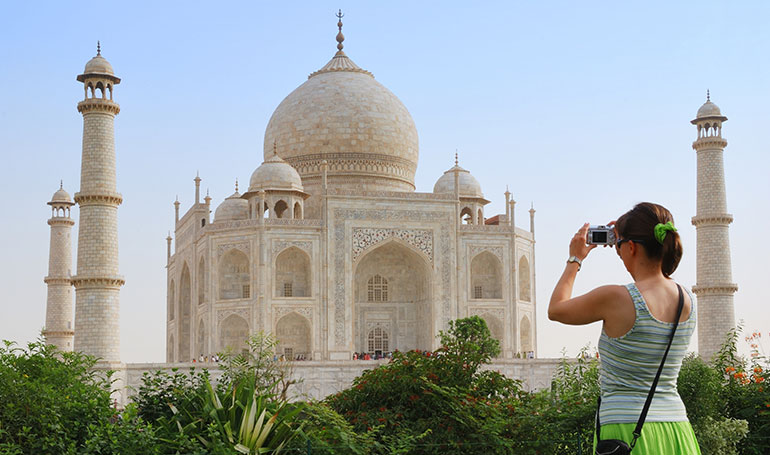
The Taj Mahal is the epitome of Mughal art and one of the most admired architectural masterpieces in the world. Revered the world over as the ultimate symbol of love this ivory-white marble mausoleum is much more than meets the eye.
The tomb is the representation of the house of the queen in Paradise, and its setting was based on the palace gardens of the great nobles that lined both sides of the river at Agra India. You will explore the entire complex of the Taj Mahal with an explanation of each building and an account of the mausoleum's urban setting, its design and construction, its symbolic meaning, and its history up to the present day.
Taj Mahal was built in 22 years (1631-1653) with the orders of Shah Jahan and it was dedicated to Mumtaz Mahal (Arjumand Bano Begum), the wife of Shah. The name "Taj Mahal" was derived from the name of Shah Jahan's wife, Mumtaz Mahal, and means "Crown Palace". 20.000 workers labored and 32 crore rupees were spent during the construction of the monument and it was built according to Islamic architecture.
This Unesco world heritage site is located on the right bank of the Yamuna River in a vast Mughal garden that spreads over nearly 17 hectares. For its construction, masons, stone-cutters, inlayers, carvers, painters, calligraphers, dome builders and other artisans were requisitioned from the whole of the empire and also from the Central Asia and Iran. Ustad-Ahmad Lahori was the main architect of the Taj Mahal.
Taj Mahal represents the finest architectural and artistic achievement through perfect harmony and excellent craftsmanship in a whole range of Indo-Islamic sepulchral architecture. It is a masterpiece of architectural style in conception, treatment and execution and has unique aesthetic qualities in balance, symmetry and harmonious blending of various elements.
Timing - 8:00 A.M. To 5:00 P.M.
Entrance Fee: Foreigners: Rs 750/-
Indians: INR Rs 20/-
Open on all Days
Time: Take 2+ hours to soak in the breathtaking beauty
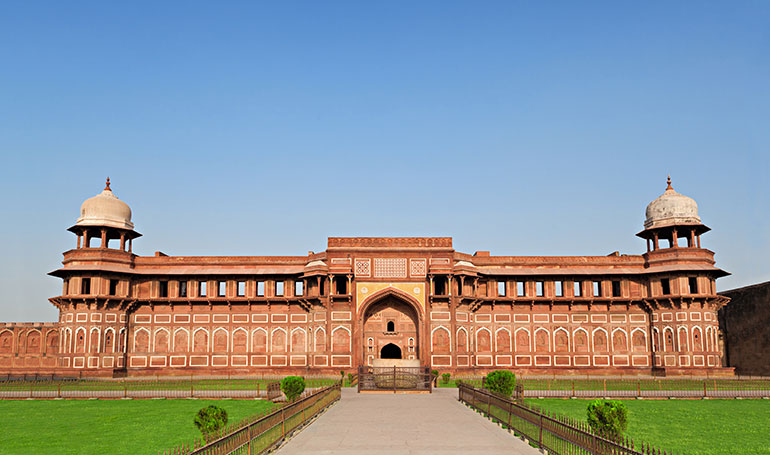
The Agra Fort is a UNESCO World Heritage site located on the right bank of the river Yamun in Agra. It is about 2.5 km northwest of its more famous sister monument, the Taj Mahal.
The Agra Fort, also known as the “Lal –Qila”, “Fort Rouge” or “Qila-i-Akbari”, is the highlight of the city of Agra, then capital of the Mughal Sultanate. This powerful fortress of red sandstone encompasses, within its 2.5-km-long enclosure walls, the imperial city of the Mughal rulers. It comprises many fairy-tale palaces, such as the Jahangir Palace and the Khas Mahal, audience halls, such as the Diwan-i-Khas; and two very beautiful mosques.
Constructed by the Mughal emperor Akbar in 1565 on the remains of an ancient site known as Badalgarh – it was a symbol of power, strength and resilience, as it stands today in full glory. It was built in an era marked by invasions and fortifications, where power was symbolized by grand palaces and grander forts. This walled, palatial city worked both as a military strategic point as well as the royal residence. The fort contains splendid palaces both in red sandstone and white marble built by two generations of prolific builders Akbar and later Jehangir and Shahjahan.
It is one of the most important and robustly built stronghold of the Mughals, embellished with number of richly decorated buildings encompassing the imposing Mughal style of art and architecture. Some 4000 builders daily worked on it and it was completed in 8 years (1565-1573).
Open from sunrise to sunset
Entrance Fee: Foreigners: Rs 520/-
Indians: INR Rs 20/-
Open on all Days
Time: Take 2-3 hours to soak in the place steeped in history.
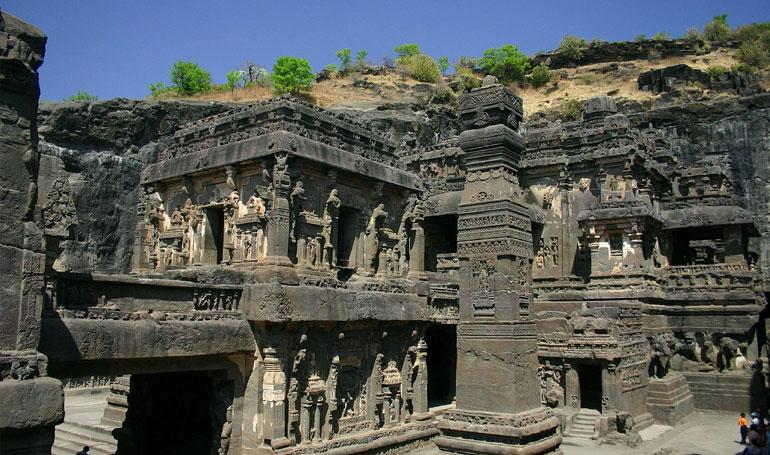
The Ellora caves, locally known as ‘Verul Leni’ is located on the Aurangabad-Chalisgaon road at a distance of 30 km north-northwest of Aurangabad. These are an impressive complex of Buddhist, Hindu and Jain cave temples built between the 6th and 10th centuries AD. It represents one of the largest rock-hewn monastic-temple complexes in the entire world.
The coexistence of structures from three different religions serve as a splendid visual representation of the prevalent religious tolerance of India. For this reason and others, the Ellora Caves were designated a UNESCO World Heritage Site in 1983.
The caves at Ellora were carved out of the vertical face of the Charanandri hills between the 6th and 10th centuries. The caves are hewn out of the volcanic basaltic formation known as ‘Deccan Trap’, the term trap being of Scandinavian origin representing the step like formation of the volcanic deposits.
The carving work began around 550 AD. The last period of building activity took place in the 10th century, when the local rulers switched allegiance from Shaivism (Hinduism devoted to Shiva) to the Digambara sect of Jainism.
The region is also famous for its antiquity. It has been inhabited since time immemorial, the stone tools belonging to the Upper Palaeolithic (around 10,000 to 20,000 years ago), Mesolithic (less than 10,000 years ago) bearing testimony to this fact. The Chalcolithic remains (2500-1000 BC) in the vicinity also indicates the continuity of human occupation in this region.
Open from sunrise to sunset
Closed on Tuesday
Entry Fee: 10 (Indians); 250 (foreigners)
Photography Charges: Nil, (Rs. 25 for video filming)
Time: Take 2-3 hours
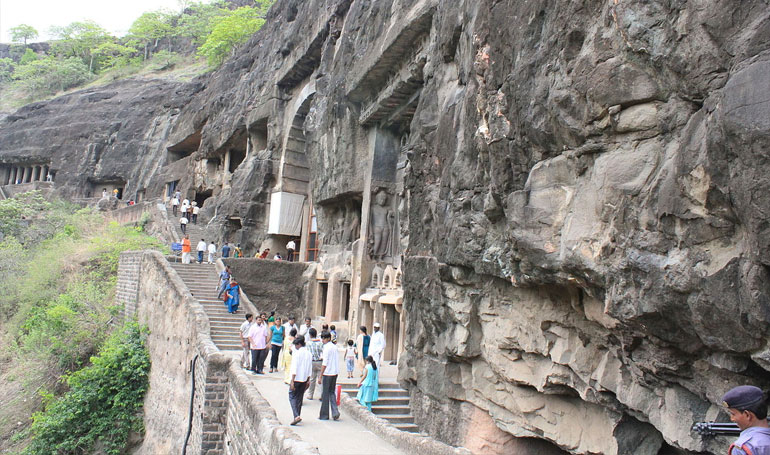
The Ajanta Caves are situated at a distance of 107 km north of Aurangabad town. There are about 30 rock-cut Buddhist cave monuments which date from the 2nd century BCE to about 480 or 650 CE. The location of this valley provided a calm and serene environment for the Buddhist monks. These caves were discovered by an Army Officer in the Madras Regiment of the British Army in 1819 during one of his hunting expeditions.
This UNESCO World Heritage Site is famous for its murals, are the finest surviving examples of Indian art, particularly painting.
In date and style, these caves can be divided into two broad groups. The earliest excavations belong to the Hinayana phase of Buddhism. The second group of caves belongs to the pre-Christian era, the earliest among them being from the second century B.C.
The world famous paintings at Ajanta also fall into two broad phases. The earliest is noticed in the form of fragmentary specimens which are datable to second century B.C. The second phase of paintings started around 5th – 6th centuries A.D. and continued for the next two centuries.
The main theme of the paintings is the depiction of various Jataka stories, different incidents associated with the life of Buddha, and the contemporary events and social life.
Hours: 8AM–5PM
Entry Fee: 10 (Indians); 250 (foreigners)
Photography Charges: Nil
(Rs. 25 for video filming)
Time: Take 2-3 hours for a walk around.
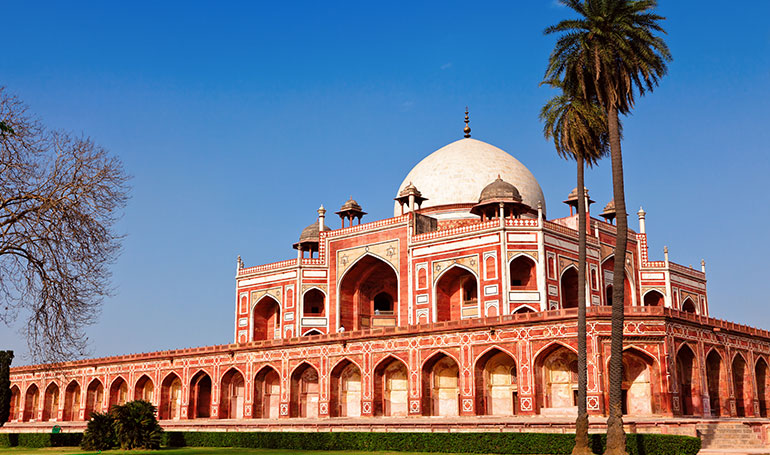
Humayun's Tomb is a synthesis of Persian architecture and Indian traditions-the former exemplified by the arched alcoves, corridors and the high double dome, and the latter by the kiosks, which give it a pyramidal outline from distance. This beautifully restored tomb of the Mughal Emperor Humayun is the first Indian building to use the Persian double dome.
Emperor Humayun's Persian wife, Hamida Begum, supervised the construction from 1562-1572 of her husband's tomb in Delhi. This masterpiece of Mughal Architecture, & inspiration of Taj Mahal designed by Persian architect Mirak Mirza Ghiyas who had previously designed buildings in Herat (now northwest Afghanistan), Bukhara (now Uzbekistan), and elsewhere in India. The location chosen for the building on (then) the bank of the Yamuna River adjoins the shrine of an important Sufi Chistiyya order saint, Nizam al-Din Awliya. The Chistiyya was particularly venerated by the Mughals.
This tomb is one of the most beautiful monuments in Delhi. It was also recognized as the World Heritage Site by UNESCO because of the brilliant architectural beauty. It involved about 15 lakh rupees for the construction. The mausoleum is surrounded by beautiful lush Mughal garden. The garden is divided in to four parts by pathways. This is typical of all Mughal gardens. The various water channels for the fountains make this tomb a true architectural delight.
Timings: Sunrise to sunset
Entry Fee: 10 (Indians),
250 (foreigners)
Photography Charges: Nil
(Rs. 25 for video filming)
Time: Take 2-3 hours for a walk around.
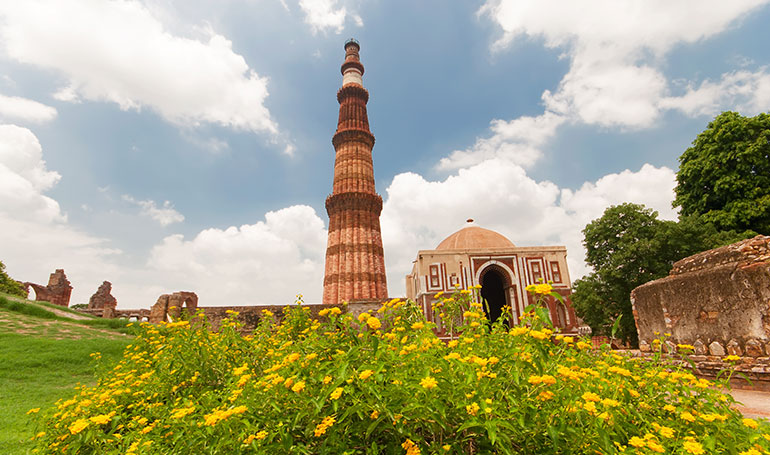
Qutub Minar, at 120 meters, is the tallest brick minarety in the world, a UNESCO World Heritage Site and the most important landmark of Delhi.
Divided into 5 stories, Qutub Minar has five projecting circular balconies with fluting on the first three storeys. The balconies act as ornamental bands, adorned with intricate and delicate carvings and inscriptions. Red sandstone has been used in the construction of the first three storeys, and both white marble and red sandstone in the last two.
This tall minaret was constructed in 1192 by Qutab-ud-din Aibak, and later completed by his successor Iltutmish. The soaring conical tower is an exquisite example of Indo-Islamic Afghan architecture. It is India's most popular monuments attracting around 3.9 million visitors every year. The base of the Qutub Minar measures 14.32 meters and the top of the structure measures 2.75 meters. The bird eye's view of Delhi city from the top is amazing. The base of first storey has alternate angular and circular flutings, the second one is round. The third storey of the Qutub Minar has angular flutings. The balconies projecting out heighten the beauty of the Minar.
The tower is so high that around 379 steps are needed to be climbed to reach the top, though for safety reasons it is not allowed anymore to climb up to the top.
There are claims and evidence that Qutubminar was built much before by Hindu emperors. Later Kuttubuddin has replaced the writing on stones. The stones has Hindu God pictures on one side and Arabic writing on other side. Stones dislodged from the Minar have Hindu images on one side with Arabic lettering on the other. Those stones are now in Museum. These stone represent that invaders used to remove the stone- dressing of Hindu buildings, turn the stones inside out to hide the image facial and inscribe Arabic lettering on the new frontage.
Address: Mehrauli, New Delhi
Visiting Hours: 7AM–5PM
Phone: 011 2469 8431
Time required: 2 Hours+
Entry Fees: Rs. 10 for Indians & Rs. 250 for Foreigners.

Hampi is charismatic even in its ruined state. It is one of the UNESCO World Heritage Sites in India located near Hospet town in the Karnataka state. During its prime Hampi the capital of erstwhile Vijaynagara empire was one of the richest cities in the world. The name Hampi can also means "champion" attracts thousands of visitors every year. Vast stretches of boulder-strewn hills make the backdrop of Hampi unique. Dotted around the hills and valleys are 500 plus monuments.
The monuments were built between AD 1336-1570. A large number of royal buildings were raised by Krishnadeva Raya (AD 1509-30), the greatest ruler of the dynasty. The period witnessed resurgence of Hindu religion, art, architecture in an unprecedented scale.
Among them are beautiful temples, ruins of palaces, remains of aquatic structures, ancient market streets, royal pavilions, bastions, royal platforms, treasury buildings... the list is practically endless. Hampi is a curious travelers’ paradise and at the same time a pilgrim's delight.
Entrance Fee:
For Zanana Enclosure and Vitthala Temple Complex
Citizens of India and visitors of SAARC (Bangladesh, Nepal, Bhutan, Sri Lanka, Pakistan, Maldives and Afghanistan) and BIMSTEC Countries (Bangladesh, Nepal, Bhutan, Sri Lanka, Thailand and Myanmar) - Rs. 10 per head.
Other Foreign Nationals: Rs. 250/- per head
Time required: 1-2 days
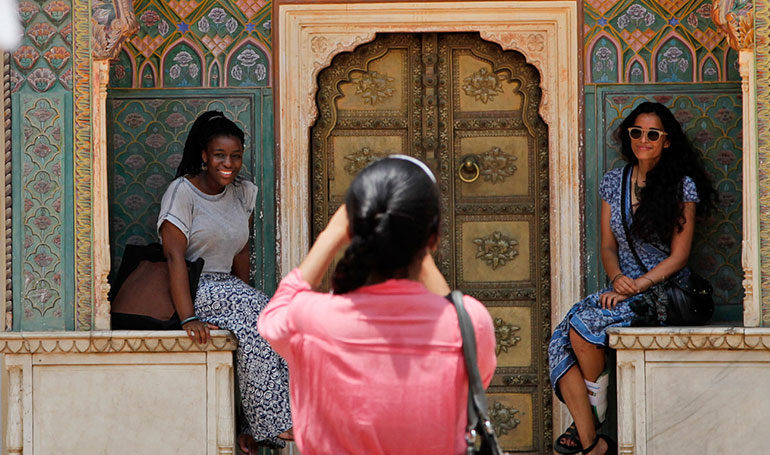
The City Palace is located in the heart of the Pink City Jaipur. This is also called the City Palace Museum. The Palace has been designed according to a 'grid style' and houses various structures such as, 'Chandra Mahal', 'Mubarak Mahal', 'Diwan-I-Khas' and the 'Govind Dev Ji Temple. Some of the intricately designed famous gates are the 'Udai Pol', 'Jaleb Chowk', 'Tripolia Gate' and 'Virendra Pol', which also happen to be the various entrances to the palace.
The palace was built between 1729 and 1732 AD by Sawai Jai Singh II. He ruled in Amer and planned and built the outer walls of the palace and later rulers added to the architecture of this palace. These additions have been known to take place right up to the 20th century.
The City Palace reflects Rajput, Mughal and European architectural styles although the palace was designed to Vaastushastra treatise.
Address: Jalebi Chowk, Near Jantar Mantar, Tripolia Bazar, Jaipur, Rajasthan 302002
Hours: Closing soon · 9:30AM–5PM
Phone: 0141 408 8888
Time required: 3-4 hours
Entry Fee: Indian: Rs. 35.00 &
Foreigner: Rs. 150.00
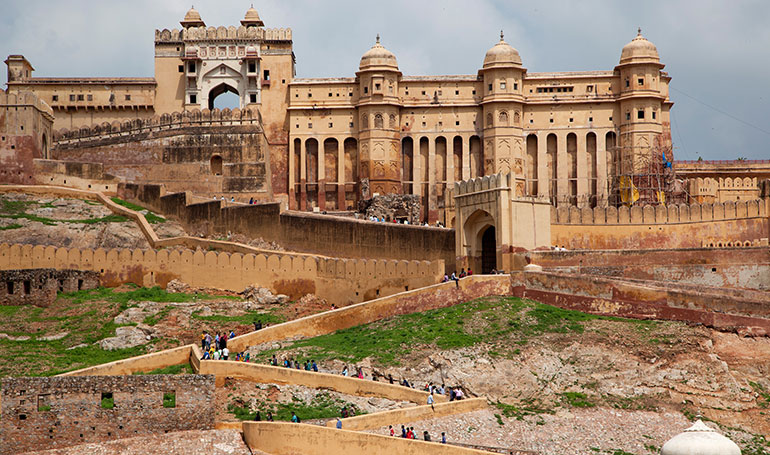
Amer (Amber) Fort is located high on a hill and is the principal tourist attraction in the Jaipur area. The magnificent Amber Fort overlooking Maota Lake is known for its artistic style, blending both Hindu and Muslim architecture. With its large ramparts, series of gates and cobbled paths, it was built in 16th century by Man Singh, one of the first war chiefs or the trusted general of the Emperor Akbar.
This fort is also very popularly known as the Amer Palace. On the inside it boasts of various buildings of prominence like the 'Diwan-i-Aam', the 'Sheesh Mahal' and the 'Sukh Mahal'. This fort also has the 'Shila Devi' Temple and the 'Ganesh Pol' which is a gate that leads to the private palaces of the kings. The structure has four different parts, each with a separate entrance. A very famous attraction here is the 'Magic Flower', a fresco carved out of marble. The fort also has many pavilions and halls of great interest.
Visiting Hours: 8:00 AM – 6:00 PM
Contact No: 0141 253 0293
Entry Fee: Indian: Rs. 25.00 Student: 10 &
Foreigner: Rs. 200.00 Student: 100
Elephant Ride at Amber Palace for two persons Rs. 900/-
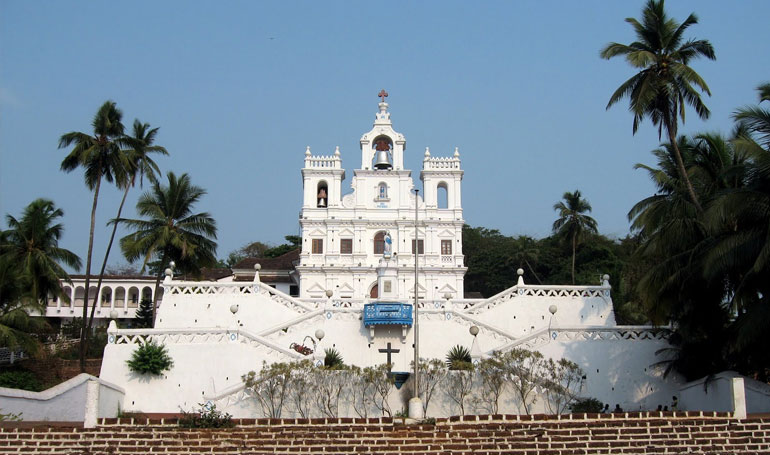
Goa's famous and magnificent churches are largely a legacy of Portuguese colonization. They are an important factor in Goa's social, cultural and religious life. For example, the contribution of the Church to education in Goa is immense. Today the churches are all part of the Archdiocese of Goa and function with its help, many are also protected sites.
The church architecture in Goa, can be broadly broken down to the following periods.
The Early period - From 1510 - 1550 AD: The oldest surviving Church in Goa today is the Church of Our Lady of Rosary on Monte Santo, Old Goa. Built on the site of Alfonso de Albuquerque's hill of Victory soon after he conquered Goa in 1510. The style of Churches during this time period is termed as "Manueline" after King Emmanuel of Portugal.Some notable churches of this era include the Church at the Cabo near Panaji and the Church on the Island of Divar off the coast of Old Goa.
The Baroque period - From 1550 - 1660 AD: This period coincides with the Renaissance period in Europe and also coincides with the period of "Golden Goa". Church building during this time reached a fever pitch with styles and plans that are totally European.The great churches of Old Goa including the Basilica of Bom Jesus and the Se Cathedral, and the Church of St Cajetan and the largest of them all, the Augustine Church of Our Lady of Grace, now in ruins, belong to this time period and style.
The Indian baroque period - From 1660 - 1760 AD: The churches of this period represent the local contribution to church building in terms of style and design. The prominent churches of this period include the Church of St Francis of Assisi at Old Goa, The Church of Holy Spirit at Margao and the Church of St Ana at Talaulim and The Church of Our Lady of Compassion at Divar.
The Rococo period - From 1760 - 1899 AD: The churches of this period are characterized by their rather small size but with an accent on exquisite and ornate finishing on the inside with local motifs and paintings. Another element was the use of Stucco on the exterior facade. One of the classical examples of this style is the Church of St. Stephen's at San Estevan near Panaji. Others include the Church of Our Lady of Immaculate conception at Moira, the Church of St Alex at Calangute and the Church of Our Lady of Rosary at Margao.
The modern period - From 1900 onwards: This period dates from the early nineteenth century onwards. There is a multitude of different styles and represents the freeing of the rigid structure of the past. Some examples include the Church of Nossa Senhora at Saligao built in the gothic style. Most of the churches are functioning institutions and can be seen and prayed in. Most are revered by both Hindus and Christians alike because of their past.
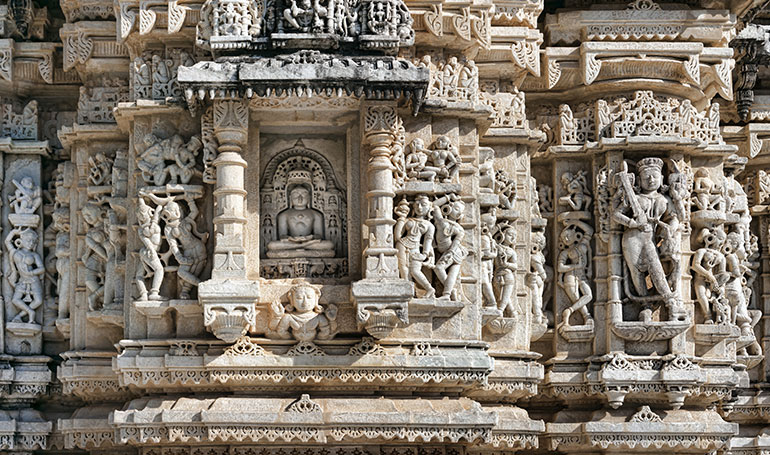
The Sun Temple of Konark in Odisha is a UNESCO world heritage site and a massive conception of artistic magnificence and engineering dexterity. King Narasimhadeva I, the great ruler of the Ganga dynasty had built this temple, with the help of 1200 artisans within a period of 12 years (1243-1255 A.D.). On the shores of the Bay of Bengal, bathed in the rays of the rising sun, the temple at Konarak is a monumental representation of the sun god Surya’s chariot; its 24 wheels are decorated with symbolic designs and it is led by seven pairs of horses. Majestic in conception, this Temple is indeed one of the most sublime monuments of India, famous as much for its imposing dimensions, faultless proportions and harmonious integration of architectural grandeur. The Sun temple belongs to the Kalinga School of Indian Temples with characteristic curvilinear towers mounted by Cupolas.
Hours: Open Daily · 6AM–8PM
Phone: 06758 236 821
Time required: 2 Hour
Entry Ticket: Rs. 10 for Indians & Rs. 250 for Foreigners.
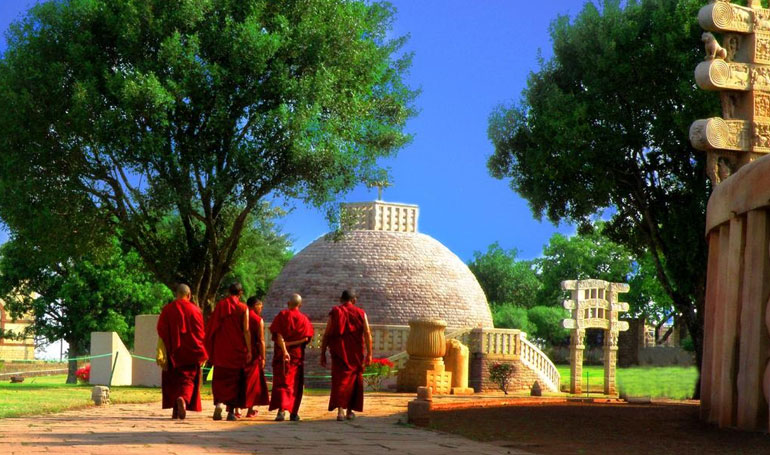
The Sanchi stupa, built in and around 283 BCE by Ashoka, the famous Indian emperor who converted to Buddhism. The Buddhist vihara at Sanchi, famous for its Great Stupa is 46 km north-east of Bhopal - the capital city of Madhya Pradesh, India.
Stupas are large hemispherical domes, containing a central chamber, in which the relics of the Buddha were placed. The Stupa at Sanchi is one the most wonderful structures of ancient India. It has been included by the UNESCO as one of the heritage sites of the world. The most important of all the Sanchi monuments is the Sanchi Stupa - a fine example of the development of the Buddhist architecture and sculpture beginning from the 3rd century B.C. to the 12th century A.D. The site of Sanchi was discovered in the year 1818 by General Taylor and an archaeological museum was established in 1919y Sir John Marshall.
Hours: 7AM–7:00PM, open on all days.
Phone: +91-755-2746827
Time required: 2 Hour
Entry Ticket: Rs. 10 for Indians & Rs. 250 for Foreigners
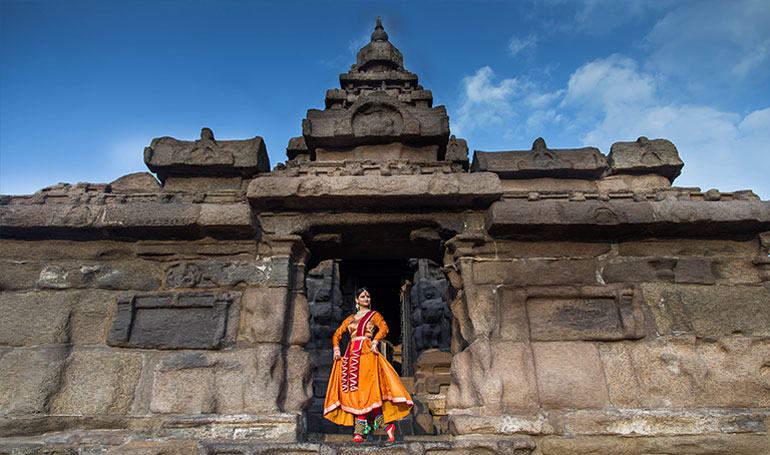
Shore temple is a complex of three temple is so named because it overlooks the shore of the Bay of Bengal. It is a structural temple, built with blocks of granite, dating from the 8th century. The current Shore Temple is the only one of seven such structures that has survived the ravages of time weather and the erosion by sea water. A keen eye cannot miss the fine details of 'apsaras' and animals carved on the two pagodas, and the small tank on the northern side.. The two pagodas (towers) actually house three deities - 16 faced Shiva linga on the east, Somaskandha (Subramanya sitting on the laps of Shiva and Parvathi) on the western tower (facing west), and the reclining Maha Vishnu (Ranganatha) again on the western tower but seen on its east entrance.
Hours: 6AM–6:00PM, open on all days.
Time required: 1 Hour
Entry Ticket: Rs. 10 for Indians & Rs. 250 for Foreigners;
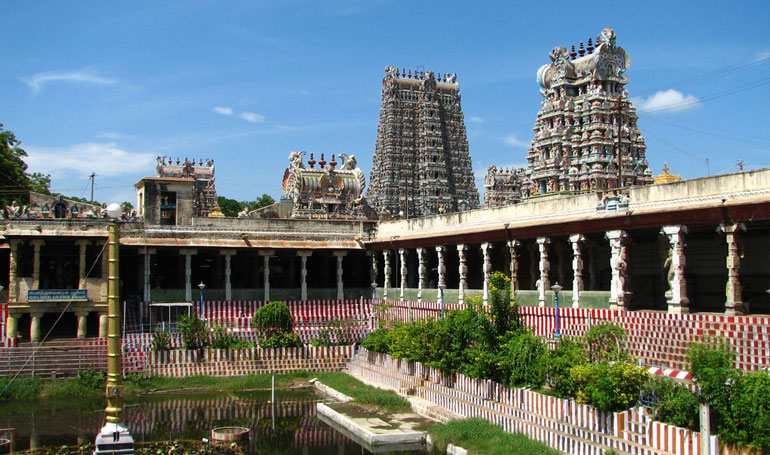
Madurai also known as Temple City has been a major settlement for two millennia and is one of the oldest continuously inhabited cities in the world. At the heart of it is Meenakshi Amman Temple located on the southern bank of the Vaigai River. It is dedicated to Parvati, known as Meenakshi, and her consort, Shiva, here named Sundareswarar. The present structure was built between 1623 and 1655.The temple forms the lifeline of the 2,500-year-old city of Madurai. It attracts 15,000 visitors a day, around 25,000 on Fridays. There are an estimated 33,000 sculptures in the temple. The annual 10-day Meenakshi Tirukalyanam festival, celebrated during April and May, attracts 1 million visitors.
Hours: 9AM–7:00PM, open on all days.
Phone: Phone: 0452 234 4360
Time required: 2-3 Hours
No Entry Fee
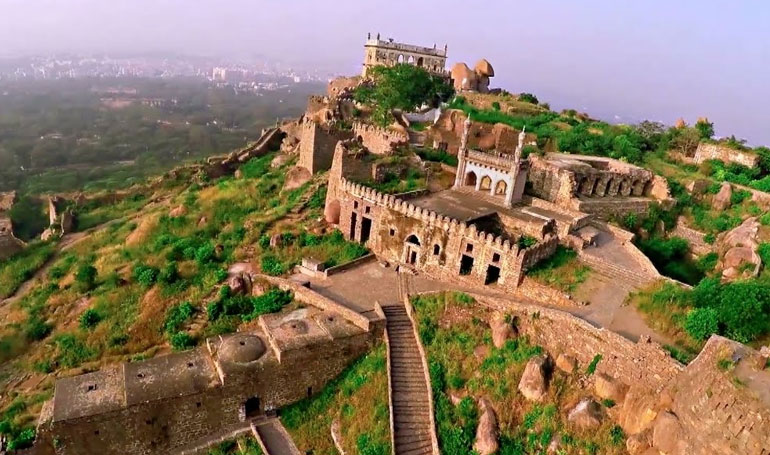
Golconda, also known as Golkonda or Golla konda, a fort of Southern India and capital of the medieval sultanate of the Qutb Shahi dynasty, is situated 11 kilometers west of Hyderabad.
According to legend, a shepherd boy found an idol in the area. When this was reported to the Kakatiyan king, he ordered a mud fort to be built around it. The fort eventually became known as Golla Konda, which in Telugu meant Shepherd’s Hill. 360 steps take you to the top of the fort giving a magnificent view of the surroundings.
Today, even after almost 800 years, the fort still stands as one of Hyderabad’s greatest architectural wonders. One of its greatest engineering marvels is the fantastic acoustic effects: one handclap at a certain point below the entrance dome can be heard at the highest point of the pavilion almost a kilometer away. This was said to be used for warning the royals in case of an attack.
Hours: 9AM–5:30PM, open on all days.
Phone: 040 2351 2401
Time required: 3 Hours+
Entry Ticket: Rs. 5 for Indians & Rs. 100 for Foreigners; 25 per camera For Videography; 130 per person Light and Sound Show Ticket
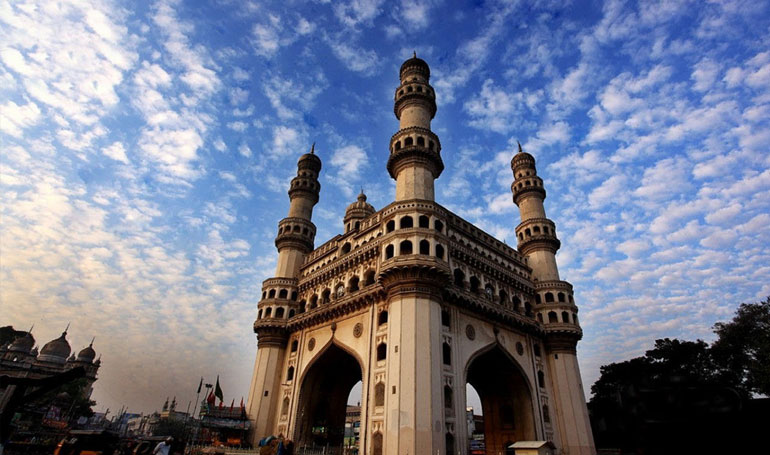
The Charminar, constructed in 1591 CE, is a monument and mosque located in Hyderabad, Telangana, India. Translated roughly as “Four Towers” or “Mosque of the Four Minarets”, the Charminar is also called by some as the Arc de Triomphe of the East and is one of the most important monuments of Hyderabad. The landmark has become a global icon of Hyderabad, listed among the most recognized structures of India.
A mosque occupies the top floor of the structure – which was also used a court during the Qutub Shah time. One account says that the sultan built it in honor of his wife, Bhagyamathi (or Bhagmathi), together with the construction of Hyderabad itself. Another, more popular, legend is that the sultan built it to honor a promise to Allah when he prayed for an end to a plague that ravaged the new city.
Hours: 9AM–5:00PM, open on all days.
Phone: 040 6674 5986
Time required: 1 Hours+
Entry Fees: Rs. 5 for Indians & Rs. 100 for Foreigners.